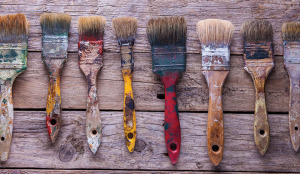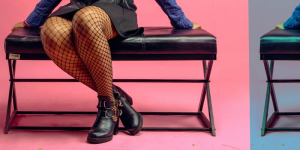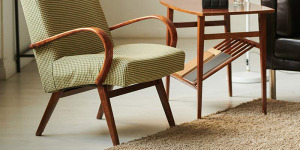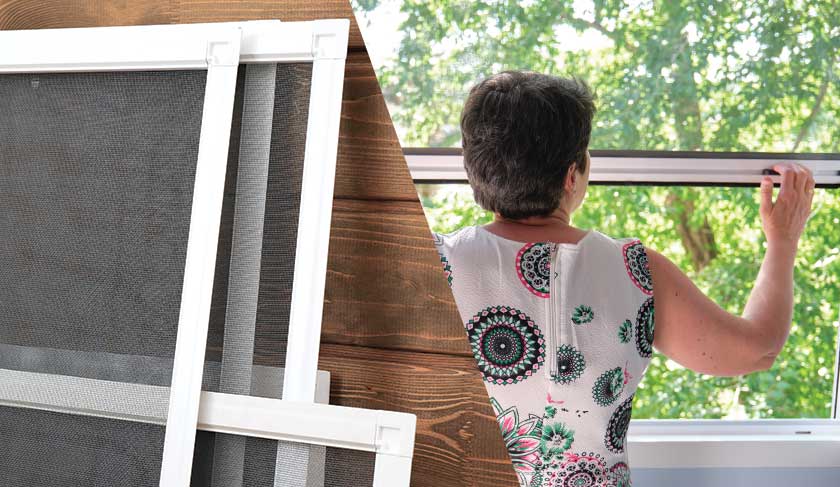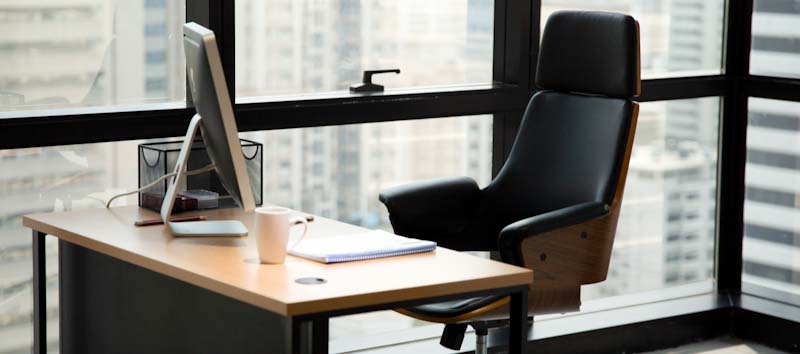
In this article, we explain how to reupholster an office chair that is in dire need of a refresh. This is not a beginner project, but if you follow these steps you should be able to give a new life to your computer chair without too much stress.
Office chairs are used for hours on end, and as a result, they wear down very quickly. In the end, they become one of the least desirable pieces of furniture in the house. With a little bit of hard work and effort, you can rejuvenate any office chair, to improve the character of your overall workspace.
What You’ll Need
- Office chair
- Screwdriver
- Spanner
- Plastic Bag
- Staple Remover
- Pliers
- Pattern Paper
- Tailors Chalk
- Heavy-Duty Scissors
- Heavy-Duty Staple Gun
- 1 Yard of Calico
- 1.5 Yards of Colored Fabric
- 1/2 Yard of Black Fabric
- Plastic and Vinyl Polish
When choosing an office chair to reupholster, make sure you don’t use a chair that you or someone else is currently using or going to need in the near future. Doing this ensures that you aren’t under pressure to get the job done, and if you end up messing it up, then it is no huge loss. You can usually find a cheap or free used office chair or computer chair from a friend or second-hand store.
Inspect the chair and make sure that it can be taken apart. You don’t want to be stuck with a chair made of molded plastic pieces that you can’t remove. Also choose an office chair with a simple style, rather than many complicated pieces or shapes. You may find an older, vintage office chair easier to reupholster due to the simpler design.
For more details on tools, refer to our article on upholstery tools and supplies here.
How to reupholster an office chair – Step by Step
#1 Take Lots of Photos
Because of how complex an office chair design can be, it’s important to take lots of photos before you even begin the project.
Pay close attention to how every single part of the chair is assembled, before you begin removing any bolts, screws, or hardware. You will need these photos as a point of reference once you have finished the actual reupholstering.
#2 Disassemble the Office Chair
Next, after you have taken plenty of photos of the chair, it’s time to start disassembly. Most office chairs have two cushions, one for the seat and one for the back. You’ll need to find the screws that hold each of these cushions in place. Sometimes, it may be necessary to fully disassemble the chair, in order to detach the cushions.
Keep in mind, that some office chairs will use a black plastic trim along the edge of the cushion in order to hide any unsightly screws or staples. If your chair has one of these covers, then you’ll need to remove that as well using a flathead screwdriver. These will generally pop off the moment you put any real pressure on them.
For more complex office chairs, make sure to take plenty of photos while you are actually disassembling them, as this will give you a better frame of reference when it’s time to reassemble the individual parts.
Office Chair: Add More Cushion – View Video on YouTube
#3 Remove the Old Fabric
Once you have successfully removed all of the cushions from your office chair, is time to remove any old fabric. Place each of the cushions face down so that you are able to see the wood layer underneath. Chances are, there is a piece of black fabric that covers the staples. Unfortunately, this fabric is so lightweight that it will easily rip when you start to take it off. Don’t worry because you will be replacing this later on.
Start by ripping off the original cover sheet, and then using your staple remover, gently lift each staple from the wood, one at a time. If any of the staples give you a hard time coming out, use a pair of pliers to grab a hold of the staple wire and twisted it out. Make sure that you have a bowl or jar in which to discard all of the staples, otherwise, you may accidentally step on a staple later on.
Once you have successfully removed all the staples that hold the fabric in place, carefully remove the fabric and lay it out flat. You will need to use the original pieces in order to create a proper pattern later. The longer it lays flat, the easier it will be to get an accurate pattern.
Once the fabric has been completely removed from both cushions, flip them over and inspect the foam. Pay close attention to any foam that seems to be damaged, or is no longer able of keeping its shape. When foam gets to this point, it will need to be replaced completely.
#4 Create A Pattern
With the old fabric completely removed, it’s time to start creating a pattern for each individual piece. You’ll need to use some pattern paper, or even old newspapers in order to create a good pattern. Although it may be tempting to simply lay the old piece on top of the new fabric and trace around that, the individual pieces of fabric will tend to slide over top the one another, which will affect the accuracy of the cut.
Simply lay each cover on top of a sheet of paper, then use your tailor’s chalk to outline each piece. Make sure to properly label each of them as either the seat or the back cushion. Once you have properly outlined them, you need to cut out the paper to the right size. This will allow you to transfer the shape to the new fabric.
#5 Cut the Fabric
Start by laying your fabric out on a large flat surface, then place your patterns on top. If you are planning on using checks, plaids, or stripes, then it’s important to properly line up both pieces so that the patterns align once assembled. With the pieces of pattern paper on top of the fabric, simply outline them using the tailor’s chalk.
Carefully cut around the entire circumference of each individual cushion cover. You will need to make sure that you have a good pair of fabric shears to cut, as paper scissors will fray the edges of the fabric. Likewise, using fabric shears will make cutting a lot easier, due to their greater strength, sharpness, and weight.
If the fabric that you chose is not fire retardant, then you’ll need to also cut a matching piece of calico for each of the cushions. This will act as a liner between the fabric and the foam, in the event that there is a fire.
#6 Replacing the Foam
How to Replace or Upgrade Chair Seat Foam – View Video on YouTube
If the foam on your chair is damaged, you are going to need to replace it. You can generally find good foam at any local arts and craft store. This foam will need to be cut to shape, and the best way to cut foam is to use an electric carving knife.
Unlike replacing the foam on other types of chairs, working with office chairs can be a little more difficult due to the ergonomically designed shapes. Luckily, a sharp electric carving knife is more than capable of cutting out the complex shapes needed. Make sure that you are able to properly remove all of the old foam, in order to re-create it with a new piece of foam.
Be careful when removing the old foam, because it is generally adhered to the backing by spray adhesive. The easiest way to loosen up this kind of adhesive is to use a hair dryer. It only takes a little bit of heat to heat up the glue just enough to make it soft. Too much heat will melt the foam.
#7 Staple the Lining
When it comes to using a fire retardant lining made out of calico, getting it to set smoothly over the cushion can be a difficult task. The reason for this is that you are going to end up with 2 pieces of fabric on top of one another. You will want to start with the calico lining and pull it tight. Use only a few staples to hold the lining in place while you pull the shell fabric over top. This will help to ensure that both layers of fabric are taunt.
You will want to start by stapling each of the 4 sides in one spot. Flip the cushion over and verify that the patterns are aligned and that the fabric is smooth. Once you are satisfied, you can begin working all the way around the circumference of the cushion, stapling it in place as you go. Periodically flip the cushion over to ensure that it is tight and wrinkle-free. If there are any screw holes in the way, take a moment to stop what you are doing and cut the fabric from around the screw hole.
#8 Create a Dust Sheet
After you have completed both the seat and the back, it’s time to create the dust cover. The dust cover was that light fabric that you literally ripped off the chair when you disassembled it. But when you reassemble it, you are going to use a slightly better piece of fabric. In order to get it right, place the cushion down and mark around it. When it’s time to start cutting the dust cover, you want to make sure to cut about three-quarters of an inch in from the line. This piece of fabric will cover the raw edges of the skin and any staples. As with the cover, make sure to cut out any holes for screws and bolts.
#9 Reassemble the Chair
Finally, it’s time to pull out all of those photos that you took along the way because you need to reassemble everything. One step at a time, work backward through the photos until you are able to reassemble every single piece. As you go, make sure that all the screws and bolts are screwed in tightly, and that any covers are snapped back in place accordingly. Because of the wear and tear that an office chair goes through, you may also want to take this time to grease up any pivot points or springs, in order to prevent any creaks and croaks that may come from the hardware later on.
Final Thoughts on How to reupholster an office chair
There you have it, your reupholstered office chair. As you’ve seen, this is no beginner task, so we recommend you try a simpler project to start such as upholstering stools to get a feel for upholstery, before you embark on a computer chair. As mentioned earlier, start with a simple computer chair design, perhaps a vintage one from an op-shop with a simple shape that can be easily deconstructed.
Author
-

Hey, I’m Sara, co-owner of NestKoo! I’m a graphic designer and professionally trained fine artist, with a Bachelor of Arts (Fine Art) majoring in Painting. I love being close to nature, sustainable living and bringing new life to old things. My specialty in NestKoo is DIY house painting, upholstery and furniture upcycling, where I bring my skills in fine art painting and contemporary design together into a practical home DIY context.
View all posts

